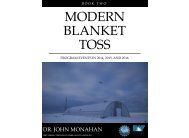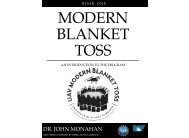Modern Blanket Toss: Findings and Observations
This book is the last in a series of three covering the National Science Foundation awarded Modern Blanket Toss project. In this book are the evaluation findings for each of the three years as well as observations from Modern Blanket Toss staff.
This book is the last in a series of three covering the National Science Foundation awarded Modern Blanket Toss project. In this book are the evaluation findings for each of the three years as well as observations from Modern Blanket Toss staff.
You also want an ePaper? Increase the reach of your titles
YUMPU automatically turns print PDFs into web optimized ePapers that Google loves.
2016 FINDINGS<br />
Figure 5. Leadership <strong>and</strong> communication scale scores for<br />
individual students over time.<br />
Leadership <strong>and</strong><br />
communication<br />
scale scores<br />
remained relatively<br />
flat for students<br />
over time (Figure 5).<br />
Leadership <strong>and</strong><br />
communication<br />
skills scale scores<br />
increased during<br />
the summer<br />
program <strong>and</strong><br />
decreased during<br />
the school year<br />
program (Figure 6).<br />
5) Student interest in STEM<br />
The attitude towards science scale score shifted positively, but only significantly<br />
for those that participated in the summer course. There was not a significant<br />
shift in the attitude toward STEM careers scale. The results are shown in Table<br />
22.<br />
Table 22 Comparison of student interest in STEM scale scores<br />
from first survey to last survey.<br />
Scale n Pre-All Post-All n Pre-Summer Post-Summer<br />
Attitudes Toward<br />
Science<br />
Attitudes Toward<br />
STEM Careers<br />
57 2.93 2.99 28 2.91 3.14<br />
57 3.19 3.17 28 3.34 3.35<br />
Note: Bold indicates a statistically significant (P < 0.05) shift.<br />
Note: The difference between the scale scores of first <strong>and</strong> last responses for individuals<br />
were compared by school location; no construct showed significant difference by location<br />
Overall the attitude toward science scale score shifted positively. Students<br />
reported the greatest changes in two items: 1) “my scientific investigations are<br />
better when I begin by asking a question,” <strong>and</strong> 2) “using a map to study scientific<br />
data help me to learn.” Table 23 details these results.<br />
Figure 6. Average leadership <strong>and</strong> communication skills scale scores by survey date. July<br />
dates represent summer post-surveys; April dates represent school year post-surveys; May<br />
<strong>and</strong> September dates represent pre-surveys.<br />
While overall students’ scale scores for attitude toward STEM careers did not<br />
increase, several individual items did increase, including 1) a career in STEM<br />
would be financially rewarding. In addition, students were less likely to agree that<br />
a career in STEM would be dull <strong>and</strong> boring <strong>and</strong> that a degree in STEM does not<br />
interest them. These are both positive outcomes.<br />
We may not have seen a large shift in the student interest in STEM scale scores<br />
because many of the students were already interested in STEM before they<br />
began participating in the <strong>Modern</strong> <strong>Blanket</strong> <strong>Toss</strong> program. Many students in the<br />
53




